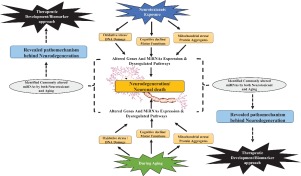Ageing Research Reviews ( IF 13.1 ) Pub Date : 2020-04-10 , DOI: 10.1016/j.arr.2020.101068 Tanisha Singh 1 , Sanjay Yadav 2

|
The progressive loss of neuronal structure and functions resulting in the death of neurons is considered as neurodegeneration. Environmental toxicants induced degeneration of neurons is accelerated with aging. In adult brains, most of the neurons are post-mitotic, and their loss results in the development of diseases like amyotrophic lateral sclerosis (ALS), Parkinson's disease (PD), Alzheimer's disease (AD), and Huntington's disease (HD). Neurodegenerative diseases have several similarities at the sub-cellular and molecular levels, such as synaptic degeneration, oxidative stress, inflammation, and cognitive decline, which are also known in brain aging. Identification of these similarities at the molecular level offers hope for the development of new therapeutics to ameliorate all neurodegenerative diseases simultaneously. Aging is known as the most strongly associated additive factor in the pathogenesis of neurodegenerative diseases. Studies carried out so far identified several genes, which are responsible for selective degeneration of neurons in different neurodegenerative diseases. Countless efforts have been made in identifying therapeutics for neurodegenerative diseases; however, the discovery of effective therapy remains elusive. Findings made in the last two decades identified microRNAs (miRNAs) as the most potent post-transcription regulatory RNA molecule, which can condition protein levels in the cell and tissue-specific manner. Identification of miRNAs, which regulate both neurotoxicant and aging-associated degeneration of brain cells, raises the possibility that roads leading to aging and neurotoxicant induced neurodegeneration cross at some point. Identification of miRNAs, which are common to aging and neurotoxicant induced neurodegeneration, will help in understanding the complex mechanism of neurodegenerative disease development. In the future, the use of natural miRNAs in vivo in therapy will be able to tackle several issues of aging and neurodegeneration. In the present review, we have provided a summary of findings made on the role of miRNAs in neurodegeneration and explored the common link made by miRNAs between aging and neurotoxicants induced neurodegeneration.
中文翻译:

microRNA在环境神经毒性和衰老诱导的神经变性中的作用。
导致神经元死亡的神经元结构和功能的逐渐丧失被认为是神经变性。环境毒物诱导的神经元变性随着衰老而加速。在成年大脑中,大多数神经元是有丝分裂后的,其损失导致肌萎缩性侧索硬化症(ALS),帕金森氏病(PD),阿尔茨海默氏病(AD)和亨廷顿氏病(HD)等疾病的发展。神经退行性疾病在亚细胞和分子水平上有一些相似之处,例如突触变性,氧化应激,炎症和认知功能减退,这在脑衰老中也是众所周知的。在分子水平上鉴定这些相似性为开发新的疗法以同时改善所有神经退行性疾病提供了希望。衰老是神经退行性疾病发病机理中最紧密相关的加性因子。迄今为止进行的研究鉴定了几种基因,它们负责不同神经退行性疾病中神经元的选择性变性。在确定神经退行性疾病的治疗方法方面已经做出了无数的努力。然而,有效治疗的发现仍然难以捉摸。最近二十年来的发现将microRNA(miRNA)确定为最有效的转录后调控RNA分子,它可以以细胞和组织特异性方式调节蛋白质水平。鉴定miRNA,同时调节神经毒性和与脑细胞衰老相关的变性的蛋白质,增加了导致衰老和神经毒性引起的神经变性的道路在某一点交叉的可能性。识别衰老和神经毒性诱导的神经变性所共有的miRNA,将有助于理解神经退行性疾病发展的复杂机制。未来,天然miRNA的使用体内治疗将能够解决衰老和神经退行性变的几个问题。在本综述中,我们提供了关于miRNA在神经退行性变中作用的发现的总结,并探讨了miRNA在衰老和神经毒性诱导的神经退行性变之间的共同联系。


























 京公网安备 11010802027423号
京公网安备 11010802027423号